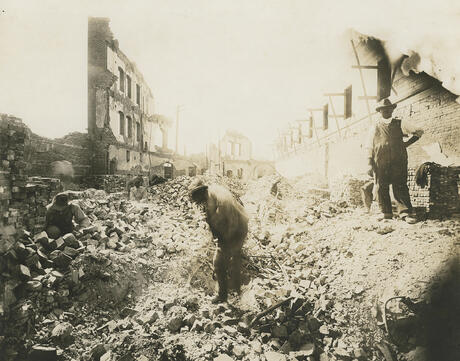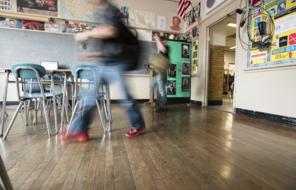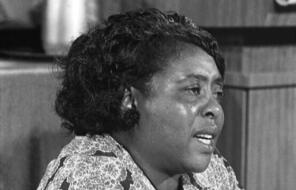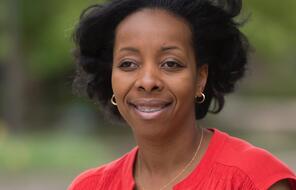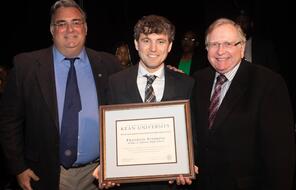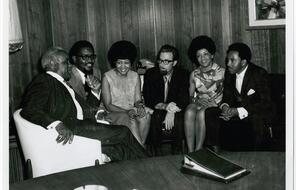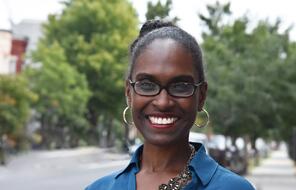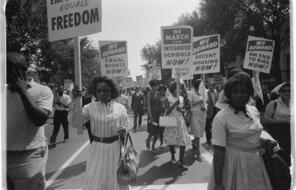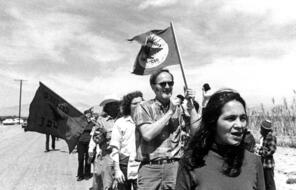What is the 1921 Tulsa Race Massacre?
Background before the massacre: In the early 20th century, the Greenwood District of Tulsa, Oklahoma was a thriving hub of Black American financial success and culture commonly known as "Black Wall Street." The Greenwood District comprised about thirty-five square blocks in which most of the Black community of Tulsa resided. This community was vibrant, proud of what they’d built, and excited to live there.
“People were going about the business of living. And some of these people were highly respectable, some of them were not highly respectable. But we all sort of blended in together and there was a sense of community. As a child, I knew that this man who ran the barbecue shack was doing it for his living, and I respected him. There were the uppers and the lowers and the middles, and it all just blended in together. I was proud to be a Tulsan. I was proud to grow up on Greenwood.”
- Hobart Jarrett, Tulsa Race Massacre Survivor
Black people primarily lived, worked, and visited here, alongside a small population of Native Americans and other people of color. There were approximately 600 Black-owned businesses situated on Black-owned land, numbers that were notable during this era. Tulsa’s Greenwood District was a haven and a model of Black success.
The Massacre: The Tulsa Race Massacre began on May 31, 1921 when a young white woman named Sarah Page was working in an elevator and screamed as Dick Rowland, a young Black man who worked as a shoe shiner, entered. People who heard the scream assumed there was an assault and called the police. This accusation led to his arrest and indictment, although the case was later dropped due to Sarah Page declining to press charges.
Upon hearing the accusation, a white mob of men, women, and even children gathered outside the courthouse demanding the lynching of Rowland. The situation escalated as Black residents, mostly World War I veterans determined to protect Rowland, confronted the mob. The mob was heavily armed, with at least one machine gun, and many had been hastily deputized by local officials. Over the next 18 hours members of the mob looted and burned Greenwood, and a number of its residents were murdered or injured.
The residents of the Greenwood District tried to defend their homes and businesses, but they were outgunned and outnumbered during this coordinated attack. Planes also flew over during the attacks and many eyewitnesses recount that they saw bullets or incendiary devices falling from the sky. When fires started to burn, Greenwood’s citizens wondered where their stalwart area firefighters were. The firefighters did try to enter the district to quell the growing flames, but were stopped by white outposts who threatened bodily harm to any firefighter who attempted to help.
"As the whites moved north, they set fire to practically every building in the African American community, including a dozen churches, five hotels, 31 restaurants, four drug stores, eight doctor’s offices, more than two dozen grocery stores, and the Black public library. More than a thousand homes were torched, the fires becoming so hot that nearby trees and outbuildings also burst into flame."
- Tulsa Race Riot: A Report by the Oklahoma Commission to Study the Tulsa Race Riot of 1921 (February 28, 2001)
The eventual official death toll was 36; however, historical investigations suggest the numbers could be much higher, with estimates ranging up to 300. Only Black citizens were indicted after the chaos subsided.
What Happened Next?
The night of the massacre, local National Guard troops were mobilized, but they spent their evening in a white neighborhood in case angry Black Tulsans decided to counter-invade, a scenario that did not come to pass. Instead, the following morning over 6,000 Black people were imprisoned in labor camps where the National Guard forced men and women to work and clean up the destruction caused by the white mob. This unlawful imprisonment ended in mid-June.
On June 2, the day after the massacre, the news of what was called a race riot made national news. The newspapers that reported on the violence shared various theories and conclusions, but few told the truth of the racial violence and total obliteration of a community. Thousands of Black residents were left homeless and destitute—the prosperous Greenwood District was utterly destroyed.
In the years after the massacre, a culture of silence pervaded Tulsa’s white and Black communities. This tragic event was rarely put into history textbooks. Even when it was included, this history was not consistently taught in K-12 schools in Oklahoma or across the nation.
On June 12, 2024 an 8-1 ruling by the Oklahoma Supreme Court dismissed a lawsuit seeking reparations from the last two remaining survivors of the 1921 Tulsa Race Massacre, Lessie Benningfield Randle, 109, and Viola Ford Fletcher, 110. No one has ever been held responsible for the murders, assault, theft, and destruction that ravaged the Greenwood District or held to account for the homelessness and loss of economic opportunity that followed.
Bringing the Tulsa Race Massacre into the Public Consciousness
It wasn’t until around the 50-year anniversary of the massacre that scholars and scientists started to uncover and openly speak about this historical erasure.
“In the early 1970s, a journalist named Ed Wheeler began studying the massacre at the suggestion of a local Tulsa editor. Refused by the publication Wheeler wrote the piece for, he ultimately published in a small periodical called Impact. In 1982, Scott Ellsworth wrote a comprehensive history called Death in a Promised Land: The Tulsa Race Riot of 1921. As this work attracted more attention and scholarship of the Tulsa Race Massacre, more articles and books followed.”
- Oklahoma Historical Society
It took decades more for this scholarship to disseminate and make its way into texts, memorials, and the larger public conscience. The past decade has seen renewed awareness and interest in examining and learning from the Tulsa Race Massacre, with efforts to recover its history, honor the victims, fight for reparations, and teach the history in Tulsa public schools. These recognitions are steps toward healing and providing an opportunity to confront the past and inspire a more inclusive future.
Understanding the Tulsa Race Massacre is a crucial component to understanding racial inequities in the American past and present. The destruction of Black Wall Street was not just a singular event but a manifestation of the systemic racism that has affected many Black communities before and since. Reckoning with and addressing the long throughline of racism in the United States is one way to move toward a society of peace, progress, and equity.
Learn More
Facing History & Ourselves is committed to examining history in order to build a safer, more equitable world. In this pursuit, Facing History staff, board members, and network of teachers and donors engage a group of academic professionals whose expertise helps to guide our projects and research. The impressive Facing History Board of Scholars includes Dr. Karlos K. Hill, Regents’ Professor of the Clara Luper Department of African and African American Studies at the University of Oklahoma.
Dr. Hill's scholarship on the 1921 Tulsa Race Massacre has offered our educators and learning community the chance to examine a painful event in US history that has been widely overlooked in public schools. In addition to working with Facing History to shine a light on the events of the Tulsa Race Massacre and the resilience of its Black residents, Dr. Hill also founded the Tulsa Race Massacre Oklahoma Teachers Summer Institute to teach this history to thousands of middle school and high school students.
Below we share links that offer more information and perspective on the Tulsa Race Massacre, including professional learning sessions Dr. Hill conducted with Facing History.
Timeline: The Tulsa Race Massacre
Oklahoma Historical Society
On-Demand Professional Learning: Commemorating the 1921 Tulsa Race Massacre with Dr. Karlos K. Hill
Listen to a conversation with Dr. Karlos K. Hill on theTulsa Race Massacre and the enduring resilience of its Black community members.
On-Demand Professional Learning: Facing the Past, Building a Shared Future
Dr. Karlos K. Hill discusses the 1921 Tulsa race massacre and the lessons this history offers. This is a recording of session three of the 2021 Global Summit..
Radio: “The 1921 Tulsa Race Massacre: A Photographic History”
In 2021 In Black America Producer/Host John L. Hanson Jr. spoke with Dr. Hill about his book The 1921 Tulsa Race Massacre: A Photographic History. Dr. Hill talks about taking on this project, where the photos came from, shining a new spotlight on the race massacre from the vantage point of its victims and survivors, and comparing these photos to those of lynchings taken elsewhere in the United States.
Podcast: Blindspot: Season 2 - Tulsa Burning
In this six-episode narrative podcast, WNYC’s KalaLea considers the life of Tulsa’s Greenwood District through the stories of the people who lived there and their descendants

